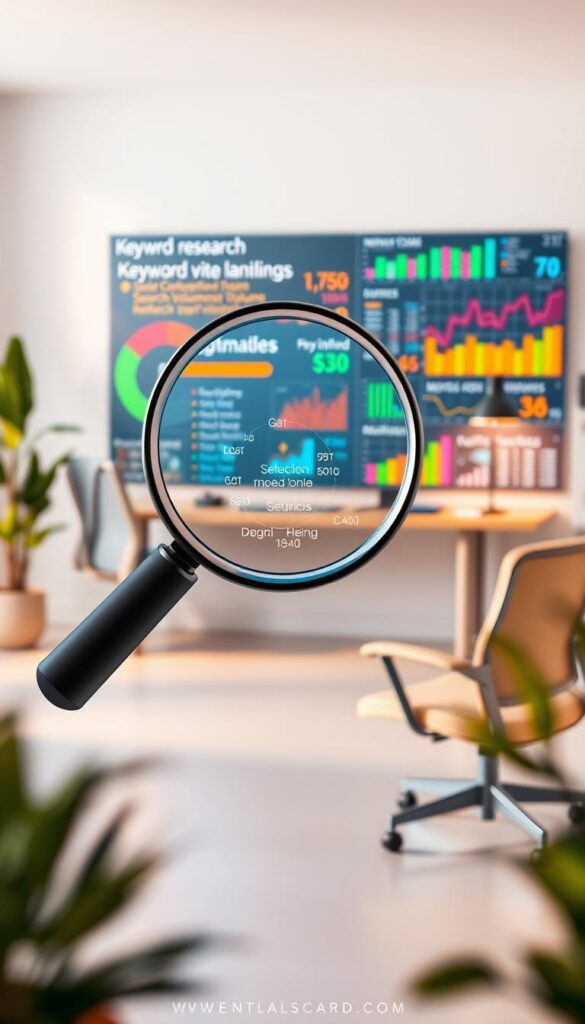
In today’s digital world, having a well-optimized website is key for businesses to thrive online. We’ll show you how to boost your website’s visibility and attract more visitors.
A detailed SEO audit is the starting point. It spots areas for improvement, making sure your site is search engine friendly and user-friendly.
Our detailed guide will take you through the critical steps of a SEO audit checklist. This will help you optimize your website effectively.
Key Takeaways
- Understand the importance of a comprehensive SEO audit for your website’s success.
- Learn how to identify areas of improvement for better website optimization.
- Discover the key elements of a thorough SEO audit checklist.
- Improve your website’s visibility and drive more traffic to it.
- Enhance your website’s overall performance and user experience.
Understanding the Importance of an SEO Audit
An SEO audit is more than just a routine check-up. It’s a vital tool that helps us improve our website’s visibility and user experience. In today’s digital landscape, a well-optimized website is crucial for attracting and retaining visitors.
As we delve into the world of search engine optimization (SEO), it’s essential to understand the role of an SEO audit in enhancing our online presence. This process involves a thorough examination of our website’s structure, content, and overall performance to identify areas for improvement.
What is an SEO Audit Checklist for Website Success
An SEO audit checklist is a comprehensive guide that outlines the necessary steps to evaluate and enhance our website’s SEO. It typically includes tasks such as analyzing on-page SEO elements, assessing technical SEO, and reviewing off-page SEO factors.
| SEO Audit Checklist Items | Description | Importance Level |
|---|---|---|
| On-page SEO Analysis | Reviewing title tags, meta descriptions, header tags, and content quality. | High |
| Technical SEO Evaluation | Assessing website speed, mobile-friendliness, and secure connections (HTTPS). | High |
| Off-page SEO Assessment | Analyzing backlink quality, quantity, and brand mentions. | Medium |
By following an SEO audit checklist, we can ensure that our website is optimized for search engines and provides a good user experience. This, in turn, can lead to improved search engine rankings and increased online visibility.
Technical SEO: The Foundation of Our Website
Technical SEO is key to our website’s success. It makes our site easy for search engines to find and rank. A solid technical SEO base ensures our site is fast, secure, and easy to use.
Evaluating Website Speed and Performance
Website speed is vital for both users and search engines. A slow site can cause people to leave quickly. We use tools like Google PageSpeed Insights to check our site’s speed and get tips for better performance.
To speed up our site, we can optimize images, use browser caching, and reduce CSS and JavaScript files. These steps can make our site much faster.
Checking Mobile Friendliness
Most people use mobile devices to access websites. So, it’s crucial that our site works well on phones and tablets. A mobile-friendly site looks great on any screen size.
We can check if our site is mobile-friendly with Google’s Mobile-Friendly Test tool. It shows us what needs fixing and how to make our site better for mobile users.
Ensuring Secure Connections (HTTPS)
A secure connection is important for both search engines and our users. HTTPS keeps data safe between our site and users’ browsers. It’s a sign of trust and safety.
To secure our site, we need an SSL certificate. Most web hosts offer these, sometimes for free. We just need to set it up on our server.
| Technical SEO Aspect | Importance | Actionable Tips |
|---|---|---|
| Website Speed | High | Optimize images, leverage browser caching, minify CSS and JavaScript |
| Mobile Friendliness | High | Use responsive design, test with Google’s Mobile-Friendly Test tool |
| Secure Connection (HTTPS) | High | Obtain an SSL certificate, configure it on your server |
On-Page SEO: Making Content Count
To make our content count, we need to focus on on-page SEO strategies that boost our search engine rankings. On-page SEO is key to how search engines rank our website.

Analyzing Title Tags and Meta Descriptions
Title tags and meta descriptions are vital for on-page SEO. They give search engines a quick summary of our webpage’s content. Optimizing title tags means making them short and to the point, with our target keywords included. Meta descriptions should grab attention and encourage clicks from search engine results pages (SERPs).
For title tags, keep them under 60 characters to avoid being cut off in SERPs. Meta descriptions should be about 155-160 characters. By optimizing these, we can boost our click-through rates (CTRs) and help search engines see our content’s relevance.
Optimizing Header Tags and Content Structure
Header tags (H1, H2, H3, etc.) are crucial for organizing our content and showing its structure. The H1 tag is for the main title, and H2 and H3 tags are for subheadings. This structure makes our content easier to read and helps search engines understand it better.
When we optimize header tags, they should be clear and include relevant keywords. This makes our content more visible for specific searches and improves the user experience by making it easier to scan.
Importance of Internal Linking
Internal linking is a strong on-page SEO technique. It helps search engines see our website’s structure and content hierarchy. By linking to relevant pages, we enhance user experience, increase engagement, and help search engines find new content.
Good internal linking means creating a clear hierarchy, using descriptive anchor text, and linking to quality content. This strategy helps with navigation and spreads link equity across our site, potentially improving our key pages’ rankings.
Off-Page SEO: Building Our Online Reputation
Creating a strong online presence needs a solid off-page SEO plan. Off-page SEO means actions outside our website to improve rankings. It’s about making our online reputation better through external signals.
Our online reputation is key for search engines to see our site as credible and authoritative. A good off-page SEO plan can make us more visible. It can also bring more traffic and increase conversions.
Assessing Backlink Quality and Quantity
Backlinks are a big deal in off-page SEO. They are links from other sites to ours. The quality and number of these links affect our site’s authority and ranking.
- Quality over Quantity: Not all backlinks are the same. Links from trusted, relevant sites are more valuable than those from low-quality or unrelated sites.
- Diverse Link Profile: A mix of links from different domains and IP addresses looks more natural and avoids spam flags.
- Avoiding Spammy Links: It’s also crucial to watch for spammy links that could damage our site’s credibility.

⭐️ Tap the exclusive deal link https://temu.to/k/uot8tcxvwum to score top-quality items at ultra-low prices. 🛍️ These unbeatable deals are only available here. Shop now and save big! ⭐️ Directly get exclusive deal in Temu app here: https://app.temu.com/m/mhb5rstagbx
Another surprise for you! Click https://temu.to/k/uag0bn0o0wd to earn with me together🤝!
Monitoring Brand Mentions and Social Signals
Brand mentions and social signals are also important in off-page SEO. Brand mentions are when our brand is talked about online, even without a link. Social signals are likes, shares, and comments on our content on social media.
- Tracking Brand Mentions: Using tools to track brand mentions helps us understand our online presence and reputation.
- Engaging on Social Media: Being active on social media boosts our brand’s visibility and drives website traffic.
- Content Promotion: Sharing our quality content on social media can lead to more shares and mentions, improving our online reputation.
By focusing on these off-page SEO strategies, we can build a strong online reputation. This supports our overall SEO efforts and drives long-term success.
Keyword Research: Getting to the Heart of SEO
At the core of every effective SEO plan lies thorough keyword research. It helps us find and target the right audience. By knowing the terms our potential customers use, we can create content that meets their needs. This improves our search engine rankings.
Keyword research is more than finding popular keywords. It’s about finding specific phrases that can drive relevant traffic to our site. This process requires creativity, analytical thinking, and understanding our target audience’s search behavior.
Identifying Target Keywords
To find our target keywords, we brainstorm a list of terms related to our business. We think about the language our audience uses, including their pain points and questions. Tools like Google Keyword Planner, Ahrefs, and SEMrush help by giving insights into search volume and competition.
Key considerations when identifying target keywords include:
- Relevance to our business and content
- Search volume and potential traffic
- User intent behind the keyword
By carefully evaluating these factors, we can narrow down our list to the most valuable and relevant keywords.
Evaluating Keyword Competitiveness
After we have our target keywords, we evaluate their competitiveness. This means analyzing how hard it is to rank for these keywords due to competition. We look at the number of competing pages, their authority, and the quality of their content.
A competitive analysis might involve examining:
| Keyword | Search Volume | Competition Level |
|---|---|---|
| SEO Audit | 2,900 | High |
| Keyword Research Tools | 1,300 | Medium |
| SEO Strategies | 5,400 | High |
Understanding the competitiveness of our target keywords helps us develop a better SEO strategy. This strategy focuses on achievable goals and maximizes our return on investment.

Content Quality: What Keeps Visitors Coming Back
High-quality content is key to keeping visitors coming back. It’s a vital part of SEO. We know that good content attracts and keeps visitors. Here, we’ll explore the importance of keeping content fresh and understanding what users want.
Reviewing Existing Content for Freshness
It’s important to regularly check and update our content. Outdated content can harm user experience and rankings. We should update content that’s no longer useful.
To review content well, we should look at:
- Relevance: Is it still good for our audience?
- Accuracy: Is the info current and correct?
- Engagement: Does it keep users interested and interactive?
By checking our content against these points, we can spot and fix any issues. This helps us serve our audience better.

Understanding User Intent
Knowing what users want is crucial for creating engaging content. It’s not just about keywords. It’s about meeting user needs.
To grasp user intent, we can look at:
| User Intent | Content Strategy |
|---|---|
| Informational | Create detailed guides and tutorials |
| Transactional | Optimize product pages and calls-to-action |
| Navigation | Ensure clear and concise navigation and internal linking |
By understanding user intent and tailoring our content, we can boost engagement. This leads to more conversions.
User Experience: A Crucial Element of SEO
User experience is key in SEO. A well-designed website can boost our search rankings. This leads to more traffic and conversions.
We must focus on two main areas: site architecture and readability. These improve user experience.
Navigating Site Architecture
A good site architecture is essential. It helps users find what they need fast. To achieve this, we should:
- Organize content in a logical and intuitive manner
- Use clear and descriptive headings and subheadings
- Implement a robust internal linking strategy
This makes our website easier for search engines to crawl. It helps them understand our content better.
Enhancing Readability and Engagement
Readability and engagement are key. They keep users on our site and lower bounce rates. To improve these, we can:
- Use clear and concise language in our content
- Optimize font sizes, styles, and colors for better readability
- Incorporate engaging multimedia elements, such as images and videos

Let’s look at how user experience factors affect SEO:
| Factor | Impact on User Experience | Impact on SEO |
|---|---|---|
| Site Architecture | Improves navigation and findability | Enhances crawlability and indexing |
| Readability | Increases user engagement | Reduces bounce rates and improves dwell time |
| Content Quality | Provides value to users | Improves relevance and authority |
By focusing on these areas, we can make a user-friendly website. This improves our SEO and user experience.
Local SEO: Connecting with Our Community
Optimizing our online presence for local search boosts our visibility. It helps us reach our target audience. Local SEO is key for businesses wanting to attract local customers and increase foot traffic.
Two important areas need our focus: optimizing our Google My Business listing and ensuring we’re listed in local directories and citations.
Optimizing Google My Business
Our Google My Business listing is often the first thing potential local customers see. To make it effective, we must keep it complete, accurate, and up-to-date. This means:
- Verifying our business to increase trust and credibility
- Providing detailed business hours, including any variations or special hours
- Using high-quality images that showcase our products, services, and business premises
- Encouraging customers to leave reviews and responding promptly to both positive and negative feedback
Importance of Local Listings and Citations
Local listings and citations on directories like Yelp and Bing Places are crucial for local SEO. They help search engines understand our business’s existence and relevance. To make the most of local listings, we should:
- Ensure consistency in our business’s name, address, and phone number (NAP) across all listings
- Choose directories that are relevant to our business and industry
- Monitor and update our listings regularly to maintain accuracy and freshness
By focusing on these local SEO aspects, we can enhance our online visibility. This drives more local traffic to our website and physical location. It also boosts our business’s bottom line.

Analytics and Tracking: Measuring Our Success
To see how well our SEO works, we need strong analytics and tracking. Knowing how people use our website helps us make smart choices.
Analytics tools give us the info to tweak our SEO plans. This way, we can reach our goals better. We find what needs work and grab chances to grow.
Setting Up Google Analytics
The first thing is to set up Google Analytics. We create an account, add the tracking code, and adjust settings to track what we need.
It’s key to make sure Google Analytics works right. This means setting up goals, events, and e-commerce tracking, based on our site’s needs.

Understanding Key Performance Indicators (KPIs)
After setting up Google Analytics, we need to know our KPIs. KPIs are measurable signs of how we’re doing toward our SEO goals.
Important KPIs for SEO include organic traffic, keyword rankings, bounce rate, and conversion rate. Watching these helps us see if our SEO is working. We can then make choices based on solid data.
- Organic traffic: The number of visitors from search engines.
- Keyword rankings: Where our site ranks for key words.
- Bounce rate: The percent of visitors who leave without doing more.
- Conversion rate: The percent of visitors who do what we want them to.
Competitor Analysis: Learning from Others
In the world of SEO, looking at our competitors can teach us a lot. It helps us make our website better and our SEO strategy stronger.
Understanding our competitors is key. By knowing who they are and what they do well, we can improve our own SEO. This helps us stand out online.
Identifying Our Top Competitors
To find our top competitors, we need to study websites that rank well for our keywords. Tools like Ahrefs or SEMrush help us see what makes them successful.
As Moz says, “Competitor analysis is more than just finding who’s in the game. It’s about seeing their moves and finding gaps we can fill.” This knowledge is vital for a winning SEO plan.
- Analyze top-ranking websites for target keywords
- Identify patterns or common characteristics among top competitors
- Use tools like Ahrefs or SEMrush for competitor analysis
Analyzing Competitor SEO Strategies
After finding our competitors, we should look at their SEO tactics. We check their keywords, content, backlinks, and technical SEO.

As stated by
“The key to successful competitor analysis is not just to identify what your competitors are doing, but to understand why they are doing it and how you can do it better.” –
By studying our competitors’ SEO, we can spot where we can improve. We can also find chances to beat them. This means looking at their strong and weak points and adjusting our plan.
For example, if our competitors miss a keyword, we can focus on it. If their backlinks are weak, we can build better ones to rank higher.
Ongoing Optimization: Keeping Our SEO Fresh
To stay ahead in the digital world, we must keep our SEO up to date. A detailed SEO audit checklist is just the start. We need to keep checking and tweaking to keep our site search engine-friendly.
Establishing a Regular Audit Schedule
Regular checks help us find what needs work and see if our ongoing optimization plans are working. We suggest doing audits every three months. This lets us catch up with search engine updates and user habits. Key areas to look at include:
- Technical SEO improvements
- Content freshness and relevance
- Backlink quality and quantity
Staying Updated with SEO Trends
Keeping up with SEO trends is key. We do this by following industry leaders, going to webinars, and joining forums. Some trends to keep an eye on are:
- The growing need for voice search optimization
- The impact of artificial intelligence on SEO
- The ongoing focus on user experience
By being proactive and flexible, we can keep our site competitive and draw in more visitors. 
Conclusion: Taking Action on Our SEO Audit Findings
Now that we’ve gone over the SEO audit checklist, it’s time to act. Our success in SEO depends on making the right changes. These changes will help our website get more visibility, attract more visitors, and improve our online image.
Prioritizing Action Items
We need to focus on the most important tasks first. This means fixing technical SEO issues, improving on-page elements, and getting quality backlinks.
Next Steps for SEO Success
To keep up with SEO success, we must keep an eye on our website’s performance. We should track important metrics and adjust our strategies as needed. This way, we can keep our online presence strong and achieve lasting SEO success.



